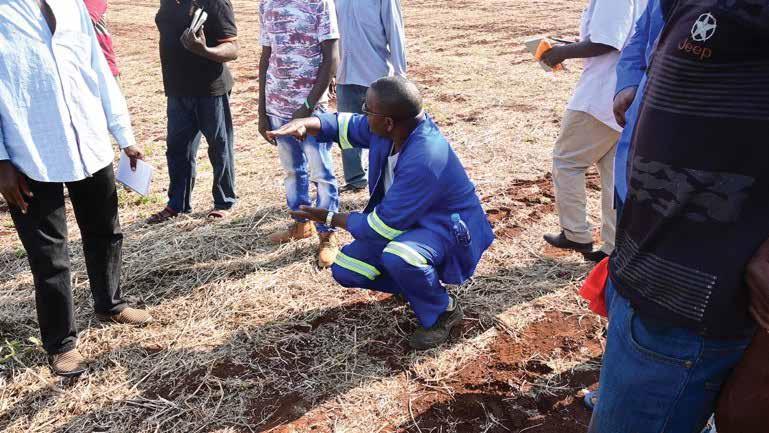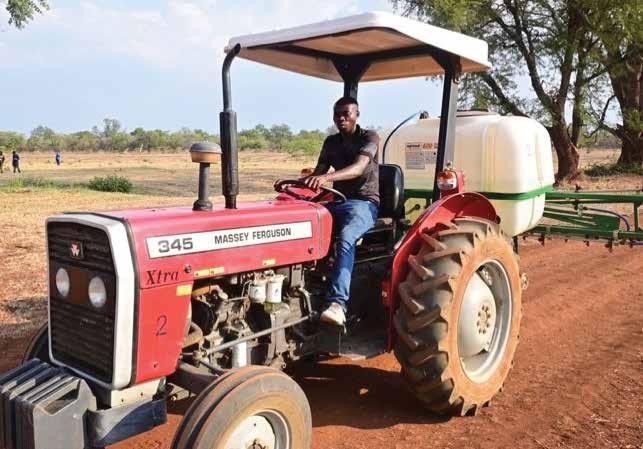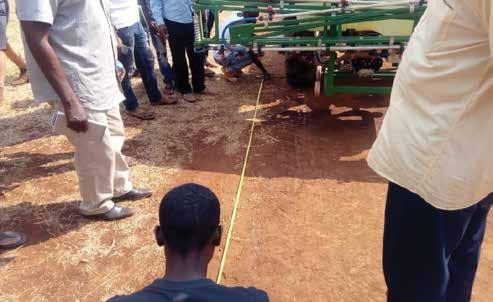
10 minute read
AKTC trains tractor service providers in crop protection application
Picture 1: Mr. Sikanyika explaining tractor operation.
BY HELMUT ANSCHÜTZ AND GENIUS CHABINGA
Advertisement
PROMOTION of agricultural Emergent farmers, commercial farmmechanisation in Zambia has ers, farm employees and multipliers of been the core mandate of the the agricultural sector have been trained Zambian-German Agricultural among other in tractor-operation, tracKnowledge and Training Centre (AKTC) tor-maintenance and -safety as well as in since its establishment as an agricul- calibration of tractor implements such as tural training centre in August 2014. In the boom sprayer, planter and fertiliser the past 6 years AKTC conducted over spreader and farming as a business. 10.000 training man days. Private sector companies are the major stakeholders and supporters of the training centre. The support of private sector partners ensures, that the Zambian farmers who get trained at AKTC have access to state of the art implements, advise and inputs. BAYER AG, CropScience Division, in Zambia represented through Bayer Zambia, is one out of 10 international private sector partners of AKTC. BAYER has a keen interest in promoting the adoption of agricultural mechaniza-
Picture 3 and 4: Taking measurements. tion among its target group of farmers worldwide. Providing professional crop The support of private protection application (PCPA) through sector partners ensures, tractor service providers will improve on that the Zambian farmers the safe use of agro-chemicals. who get trained at AKTC Other benefits by using PCPA are have access to state of the a reduced environmental impact and art implements, advise and inputs. increased operator and consumer health BAYER AG, CropScience Division, in due to reduced individual’s exposure Zambia represented through Bayer and optimized chemical inputs. For this Zambia, is one out of 10 international reason, BAYER collaborates with AKTC to private sector partners of AKTC. train farmers in mechanisation with the objective of getting farmers and tractor 38 THE ZAMBIAN FARMER VOLUME 32, ISSUE 39. 2021 service providers equipped with necessary skills and knowledge.
The three days of training, which took place from 10th to 12th of November 2020 at AKTC on the Golden Valley Agricultural Research Trust’s (GART) Chaloshi Farm in Chisamba, covered three major topics: - Tractor Operation, Maintenance and Safety, - Boom Sprayer Calibration and Safety plus -Global Positioning System (GPS) use in agriculture.
To help in mobilising mechanized service providers and farmers, AKTC engaged with the Conservation Farming Unit’s (CFU) central region office. For this specific training, CFU organised a total of 13 Tractor Service Providers (TSPs) who are also farmers themselves.
The TSPs came from four districts of the Central Province. Four farmers travelled from Mpongwe district which is about 241km away from the AKTC training centre, another four of the farmers came from Chongwe district, which is 102km from the training centre. Three more came from Serenje district and two from Mkushi district, which are 347km and 238km respectively away from the centre. All of the 13 trainees were accommodated at AKTC’s trainee house for two nights.
Owing to COVID-19 restrictions, the


BAYER was represented by Geoffrey Matutu, BAYER’s Area Sales Manager. In his talk Mr Matutu highlighted BAYER’s support of farmers in their ongoing farmer support projects and introduced the range of crop protection products available.
Picture 2: Trainee driving a tractor.
training program was set and conducted with the guidelines of the Zambian Ministry of Health (MOH), which issued a certificate that allowed AKTC to conduct the training.
TRACTOR OPERATION, SAFETY AND MAINTENANCE TRAINING
On the first day of the trainings, Tractor Operation, Safety and Maintenance was the topic of focus. The training was conducted by AKTC’s agricultural machinery expert Mr. Martin Sikanyika.
All the farmers present were tractor owners and all of them owned boom sprayers. Besides being farmers themselves, they all provide tractor services to farmers who do not own a tractor. The training started with a theoretical introduction to tractor safety, followed by a practical training in tractor operations and maintenance.
Farmers were first asked to demonstrate how they do their maintenance of air filters, engine oil checks and measuring of the tyre pressure. Furthermore, the importance of conducting such maintenances was pointed out.
During the demonstrations, the expert closely engaged himself and corrected the farmers where an action was not done right.
To ensure full farmer participation, a question-and-answer session followed the practical training, and the expert went into more detail on certain areas of tractor maintenance.
To close the Tractor Operation, Safety and Maintenance training, a farmer was asked to drive a tractor that was hooked with a boom sprayer while applying the taught operations and safety skills.
Farmers appreciated the importance of the training, as they could not wait to buy themselves a copy of the AKTC Tractor Maintenance Handbook. The handbook is a practical guide to tractor technology and on-farm tractor maintenance, which was published by AKTC last year.
BOOM SPRAYER CALIBRATION TRAINING
The second day of the training focused on the boom sprayer. This part of the training was conducted by AKTC’s crop production expert Mr. Leslie De Jager and a representative of BAYER Zambia.
BAYER was represented by Geoffrey Matutu, BAYER’s Area Sales Manager. In his talk Mr Matutu highlighted BAYER’s support of farmers in their ongoing farmer support projects and introduced the range of crop protection products available.
Afterwards, Mr. De Jager began his calibration training in which he highlighted the importance of the speed of the tractor and the pressure of the pump. Both have to be constant throughout the spraying exercise.


Moreover, the expert emphasised that in order to avoid both over- and under application of chemicals, the width of the boom, the tank capacity and the discharge has to be known.
While the training was going on, farmers pointed out the challenges they usually encounter in boom sprayer calibration. For some farmers, boom sprayer calibration was a challenge because their tractors did not have working speedometers and some boom tank markings were worn out. As a result of this, most of their calibrations were inaccurate and hence the chemicals where not applied according to the right specifications.
In response to these challenges, the expert advised some simplified ways to calculate the speed in the field, measuring the boom discharge and suggested marking the water tanks as follows:
a) For Speed.
1. Measure and mark out 100 meters of field length. 2. Set a stopwatch to zero. 3. With the correct gear and revolutions per minute (RPM), drive the tractor and start the stopwatch, beginning from the first point to the end of the 100m mark, then stop the watch and note the time taken. 4. This is the time needed for driving 100m with the specific gear and rpm. This time is later needed to calculate the discharge on 100m. Multiplied by the width of the boom gives also the area.
b) Measuring the discharge of the Boom.
1. Using the time taken from the speed calculation exercise, measure the amount of water flowing from one nozzle using a measuring jar, repeat this for at least 3 nozzles and calculate the average. 2. Multiply the average flow with the number of nozzles in the boom to get the total discharge.
c) For tank marking.
1. Get a 20l container of water. 2. Pour it into the tank and mark the level. 3. Continue pouring the 20ltr container and mark the tank in 20l, steps until its full.
By so doing, the farmer will have their tank marked with the correct readings.
After tackling the introduction to boom calibration, Mr. De Jager further talked about the meaning of nozzle colour codes and general maintenance of the boom sprayer. Different nozzle types for spraying different chemicals like herbicides, fungicides and insecticides were showcased. To summarise this topic, he talked about the best weather conditions for spraying each particular chemical. Instructions of the safe usage and handling of agrochemicals closed the morning session.
The afternoon was reserved for practical demonstrations about the boom sprayer calibration. Mr. De Jager asked for volunteers to show how they measure the width of the boom and how they clean the nozzles. After several submissions he summarized by re-emphasizing on the correct procedures and further added on other Instructions of the safe usage and handling of agrochemicals closed the morning session. procedures which were not yet mentioned. from one point to another as well as work
Together with the farmers, the practical done per measured area. speed measuring exercise was conducted, the boom discharge of water was deter- MONITORING AND EVALUATION OF mined, and different spraying patterns THE TRAINING were looked at. After the training each individual trainee was asked to fill in the AKTC training evalGPS USE IN AGRICULTURE TRAINING uation form, which is done anonymously.
On the third and last day, the Global As it could be seen from the responses the Positioning System (GPS) use in agricul- BAYER Tractor Service Provider training ture training was conducted by Mr. Genius was a success and very much beneficial to Chabinga and Mr. Lushomo Muchindu, of the farmers. AKTC. The training began with background When asked whether the content taught information on the development of the was comprehensible, all of the trainees GPS technology. (100%) indicated positive responses,
The objective of the training was to implying that the training content was very teach the farmers how to use the GPS well presented and very well understood Fields Area Measure application. The by the individual farmer. Farmers were also farmers downloaded the app from the app asked to rate the application of the taught store, where it can be downloaded free training contents in their day-to-day farm of charge and installed it on their smart activities. In response to this question, 99% phones. By using this app exact distances, of the farmers indicated that they could perimeters and field areas can determined. easily apply what they have learned with-
By having this information, farming out any problems, while one farmer did inputs and chemicals can be applied in the not indicate any response. right quantity and services can be charged As a training centre, our interest is also based on accurate distance and area. centred on finding out our experts’ perforDuring the training, farmers learned how mance during the training. Therefore, the to measure distances, the area of a given trainees were asked to rate the experts’ field, finding points by using given coordi- performance during the training and how nates and how to navigate by using both they constantly engaged them into discusmanual and GPS measurements. Later the sion. 100% of the participants indicated trainees were engaged practically, identi- positive responses on their evaluation fying different spots by using coordinates forms. as well as measuring distances and areas The three days of training was closed of the nearby fields. The farmers showed by the CFU Central Regional Manager Mr. their interest in this training by insisting on Shephard Phiri. Mr. Phiri gave a vote of being given more fields to measure. thanks to the AKTC team for training the
It was highlighted that with accurate farmers on aspects of economic variables distance and area measurements, farmers involved in the tractor service provision can apply accurate amounts of chemicals business. He further thanked the farmers and fertilisers to their fields, as well as to for availing themselves for the trainings calculate the right quantity of seeds for and hopes that they can apply the acplanting. With the use of GPS farmers can quired skills and knowledge in their dayminimize the costs of their inputs hence, to-day farming activities. saving their money and the environment from over application of chemicals. AKTC, November 2020
Furthermore, the training on GPS use Contact: in agriculture made farmers realise that it Helmut Anschuetz can help them to determine the accurate AKTC Team Leader service cost charge, as they will be able to helmut.anschuetz@afci.de factor in fuel cost per distance travelled www.aktczambia.com





